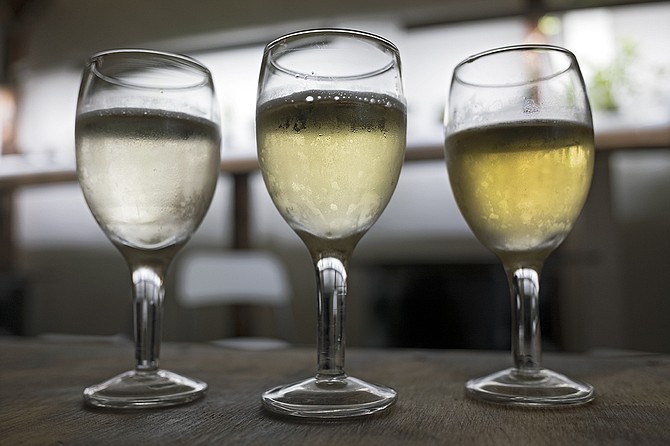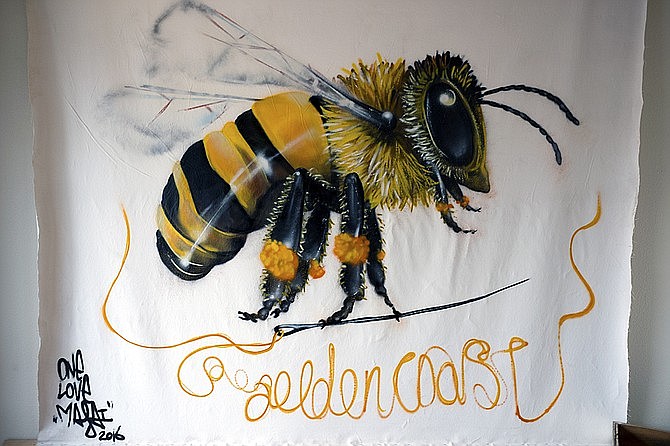 Facebook
Facebook
 X
X
 Instagram
Instagram
 TikTok
TikTok
 Youtube
Youtube

Frank Golbeck recalls the moment in 2011 that prompted him to open a meadery and tasting room in Oceanside. Golbeck and his Golden Coast Mead cofounders had spent their first year in business contract-brewing at local wineries, at whatever times equipment was made available to them. Consequently, they found themselves in a Ramona barn, in the middle of the night, making mead under the light of a cell-phone flashlight. Not the ideal circumstances for mead makers trying to make it in a craft-beer town.
By the end of 2012 they'd crowd-funded $20K to open a dedicated brewing space and small tasting room in the back of an industrial park. In December, Golden Coast moved its tasting room to the park's first row of suites, facing a large parking lot lined by retail storefronts. This more consumer-facing approach dovetails nicely with this year's sudden proliferation of meaderies in San Diego, as the ancient drink Golbeck refers to as "sunshine and flowers in a glass" seems poised to stake a greater share of the craft beverage market.
While beer and wine have enjoyed tremendous cultural and economic growth, mead has been overlooked. "You could argue mead is where those industries were 30 years ago," Golbeck says. To mead evangelists, the drink's reputation has been tarnished by low-quality "Ren faire mead," the syrupy, sweet, unsophisticated honey wine served at medieval-history–themed festivals.
Golden Coast's mead more closely resembles a dry white wine. "There's a lot of aroma and a lot of floral and honey notes," says Golbeck, "so there's a lot of perceived sweetness, but the actual residual sugar is, like, zero."

Its mead production has expanded tenfold in the past four years, barely keeping up with a rise in demand. Sales are evenly split between bottles retailing in several Atlantic states and throughout Southern California, online sales shipping direct to consumers, and tasting rooms in both Julian and Oceanside.
Locally, Golbeck hopes the sophisticated palates of craft-beer drinkers will catch up quickly to the current state of craft mead. "The progression of that market took decades," he says. “The drinker has traveled that journey from Bud Light to Anchor Steam, to all the crafts in the world."
Meanwhile, he considers the ancient craft of making mead to be wide open. "The styles have been forgotten," he says, “so we get to recreate things." Inspired by historical evidence of mead variations throughout myriad cultures spanning several continents, Golden Coast continually experiments to fill up the 12 taps of its new space — up from four in its original tasting room. Brewers try out different yeast and honey combinations and recently spent two years developing the world's first (intentionally) sour mead.
Nevertheless, Golbeck stresses, "Our highest and best use as mead-makers is to elevate the honey." He cites Golden Coast's award-winning orange-blossom mead, its honey made by bees circulating local citrus farms, as "a representation of Southern California." He also describes an organic fair-trade honey Golden Coast sourced from a UNESCO world heritage site in the Yucatán, "When you drink it," he says, "you're drinking the Yucatán jungle."


Frank Golbeck recalls the moment in 2011 that prompted him to open a meadery and tasting room in Oceanside. Golbeck and his Golden Coast Mead cofounders had spent their first year in business contract-brewing at local wineries, at whatever times equipment was made available to them. Consequently, they found themselves in a Ramona barn, in the middle of the night, making mead under the light of a cell-phone flashlight. Not the ideal circumstances for mead makers trying to make it in a craft-beer town.
By the end of 2012 they'd crowd-funded $20K to open a dedicated brewing space and small tasting room in the back of an industrial park. In December, Golden Coast moved its tasting room to the park's first row of suites, facing a large parking lot lined by retail storefronts. This more consumer-facing approach dovetails nicely with this year's sudden proliferation of meaderies in San Diego, as the ancient drink Golbeck refers to as "sunshine and flowers in a glass" seems poised to stake a greater share of the craft beverage market.
While beer and wine have enjoyed tremendous cultural and economic growth, mead has been overlooked. "You could argue mead is where those industries were 30 years ago," Golbeck says. To mead evangelists, the drink's reputation has been tarnished by low-quality "Ren faire mead," the syrupy, sweet, unsophisticated honey wine served at medieval-history–themed festivals.
Golden Coast's mead more closely resembles a dry white wine. "There's a lot of aroma and a lot of floral and honey notes," says Golbeck, "so there's a lot of perceived sweetness, but the actual residual sugar is, like, zero."

Its mead production has expanded tenfold in the past four years, barely keeping up with a rise in demand. Sales are evenly split between bottles retailing in several Atlantic states and throughout Southern California, online sales shipping direct to consumers, and tasting rooms in both Julian and Oceanside.
Locally, Golbeck hopes the sophisticated palates of craft-beer drinkers will catch up quickly to the current state of craft mead. "The progression of that market took decades," he says. “The drinker has traveled that journey from Bud Light to Anchor Steam, to all the crafts in the world."
Meanwhile, he considers the ancient craft of making mead to be wide open. "The styles have been forgotten," he says, “so we get to recreate things." Inspired by historical evidence of mead variations throughout myriad cultures spanning several continents, Golden Coast continually experiments to fill up the 12 taps of its new space — up from four in its original tasting room. Brewers try out different yeast and honey combinations and recently spent two years developing the world's first (intentionally) sour mead.
Nevertheless, Golbeck stresses, "Our highest and best use as mead-makers is to elevate the honey." He cites Golden Coast's award-winning orange-blossom mead, its honey made by bees circulating local citrus farms, as "a representation of Southern California." He also describes an organic fair-trade honey Golden Coast sourced from a UNESCO world heritage site in the Yucatán, "When you drink it," he says, "you're drinking the Yucatán jungle."
Comments